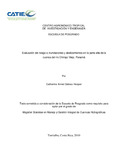Evaluación del riesgo a inundaciones y deslizamientos en la parte alta de la cuenca del río Chiriquí Viejo, Panamá
Description
Tesis (Mag Sc.) -- CATIE, 2010
Abstract
EI objetivo fue evaluar el riesgo a inundaciones y deslizamientos en la zona de estudio, para generar información de base que cubra aspectos de identificación de áreas susceptibles a riesgos por deslizamiento (metodología de Vahrson Mora) e inundaciones (modelo de simulación "Floodarea" y mapeo comunitario), así como información sobre las percepciones locales y estrategias para reducir los riesgos. Se caracterizaron los eventos históricos, así como también se estimó la vulnerabilidad y se ubicaron las áreas más vulnerables con la ayuda de los sistemas de información geográfica (SIG). La comunidad que muestra más afectación es Guadalupe, por lo que los elementos localizados en esta área corren el riesgo de ser destruidos o severamente dañados de presentarse una fuerte avenida. Referente al mapeo comunitario de riesgo se observó que existe mucha similitud con lo elaborado con SIG, la diferencia fue que los habitantes marcaron los lugares muy puntuales, donde el efecto era muy visible o actual, en cambio con el uso de SIG, se pueden definir otras zonas que de acuerdo a los parámetros o indicadores y sus pesos no se pueden determinar a simple vista. Sobre la percepción de los habitantes en cuanto a las estrategias para reducir los riesgos a inundaciones y deslizamientos, los mismos indican que en la zona de estudio, no se cuenta con la preparación ni capacitación para hacerle frente a estas amenazas, de igual forma consideran que se deben implementar estrategias concretas para reducir las mismas y el establecimiento de planes de emergencia. Its objective was to assess the risk to flooding and landslides in the study area. For this purpose, three main activities were carried out. Firstly, gathering of baseline information encompassing those aspects as landslide hazardous area identification (Vahrson-Mora Method), and flooding (Floodarea simulation and communitarian mapmaking). Second, identification of local communities’ perceptions and strategies for risk reduction. And third, historical events of Flooding and landslide were gathered, this included the pinpointing of the most vulnerable areas with the support of GIS. Although these maps point all communities as vulnerable to floods, the elements located at Guadalupe appear as the most Iikely to be destroyed or severely damaged in case of flooding. The communitarian mapmaking results overlap lo those obtained through the GIS. The main difference between the two methods lay in the flood hazards identified. For instance, the participatory method identified those hazards that were evident lo the eye. Conversely, the GIS identified hazards that were not evident to the naked eye. Finally, concerning habitants' perceptions to the strategies aimed to reduce the risks to flooding and landslide, it indicates that habitants are not trained nor prepared to deal with these hazards. The habitants consider that concrete strategies in order to reduce the hazards should be implemented and emergency plans should be created.
Keywords
Publisher
Centro Agronómico Tropical de Investigación y Enseñanza (CATIE), Turrialba (Costa Rica)
URI (Permanet link to cite or share this item)
https://repositorio.catie.ac.cr/handle/11554/5072Collections
- Tesis [1392]


